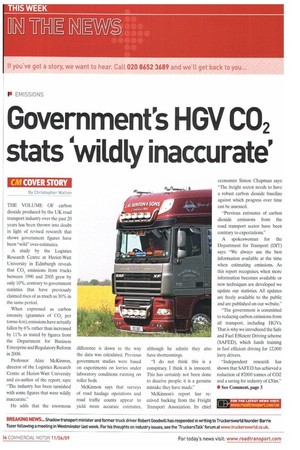P EMISSIONS
Page 6

If you've noticed an error in this article please click here to report it so we can fix it.
Government's HGV CO, stats inaccurate'
CM COVER STORY By Christopher Walton THE VOLUME OF carbon dioxide produced by the UK road transport industry over the past 20 years has been thrown into doubt in light of revised research that shows government figures have been "wild" over-estimates.
A study by the Logistics Research Centre at Heriot-Watt University in Edinburgh reveals that CO, emissions from trucks between 1990 and 2005 grew by only 10%, contrary to government statistics that have previously claimed rises of as much as 30% in the same period.
When expressed as carbon intensity (grammes of CO2 per tonne-km), emissions have actually fallen by 6% rather than increased by 11% as stated by figures from the Department for Business Enterprise and Regulatory Reform in 2008.
Professor Alan McKinnon, director of the Logistics Research Centre at Heriot-Watt University and co-author of the report, says: The industry has been tarnished with some figures that were wildly inaccurate."
He adds that the enormous difference is down to the way the data was calculated. Previous government studies were based on experiments on lorries under laboratory conditions running on roller beds.
McKinnon says that surveys of road haulage operations and road traffic counts appear to yield more accurate estimates, although he admits they also have shortcomings.
"I do not think this is a conspiracy. I think it is innocent. This has certainly not been done to deceive people; it is a genuine mistake they have made."
McKinnon's report has received backing from the Freight Transport Association. Its chief economist Simon Chapman says: "The freight sector needs to have a robust carbon dioxide baseline against which progress over time can be assessed.
-Previous estimates of carbon dioxide emissions from the road transport sector have been contrary to expectations."
A spokeswoman for the Department for Transport (DIT) says: "We always use the best information available at the time when estimating emissions. As this report recognises, when more information becomes available or new techniques are developed we update our statistics. All updates are freely available to the public and are published on our website."
"The government is committed to reducing carbon emissions from all transport, including HGVs. That is why we introduced the Safe and Fuel Efficient Driving scheme (SAFED), which funds training in fuel efficient driving for 12,000 lorry drivers.
"Independent research has shown that SAFED has achieved a reduction of 87,000 tonnes of CO2 and a saving for industry of £30m."
• See Comment, page 3
• ,, FOR THE LATEST NEWS VISIT: I 7-7 www.roadtransport.comicm
















































































































































